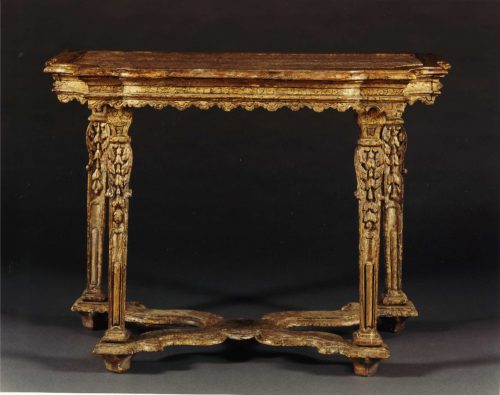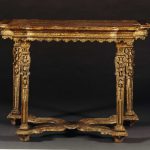9079 A LATE BAROQUE CARVED AND MARBLEIZED SIDE TABLE WITH INSET LUMACHELLA MARBLE TOP Italian. Circa 1720. Measurements: Height: 32 1/2″ (82cm) Width: 45 3/4″ (116cm) Depth: 25 3/4″ (65 1/2cm)

ResearchOf carved limewood retaining its original painted marbleized decoration. The shaped inset lumachella marble top with a painted molded edge above a molded frieze with a continuous shaped apron, the whole raised on four square tapering legs carved with acanthus leaves and harebell pendants, the legs joined by a shaped x-stretcher, each raised on a shaped foot. Very old repair to marble top.
Originating in 17th century Italy, particularly in Rome, the baroque style is characterized by curvaceous and heavily carved design, replete with architectural elements, with pieces often “intended as sculptural decorations for a gallery or hall rather than as useful objects.”1 The present side table is a late baroque example of architectonic form, composed of “boldly carved supports incorporating…fronds of acanthus.”2 A further element typical of the baroque employed in the table is the carved lambrequin frieze. Lastly, the flat x-stretcher is an Italian conceit that appears on baroque tables, secretaries and seat furniture of the early 18th century.
The piece also exhibits a few surprising features for a table of this date. The shaped top to the present table is geologically interesting, made from lumachella. It is derived from the Italian word for “snail” (lumaca) and is largely composed of marine fossil shells. The top is inset, unlike other stone tabletops of this period which simply rest on their bases. This is complimented by the unusual use of white-ground marbleizing on the table base.
Footnotes:
1. Fleming, John, and Hugh Honour. The Penguin Dictionary of Decorative Arts. London: Allen Lane, 1977. 57.
2. Ibid.

Comments are closed.